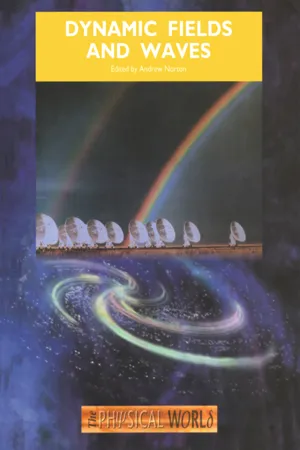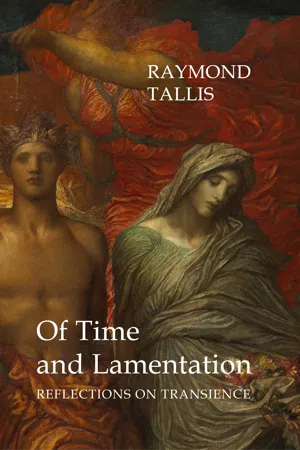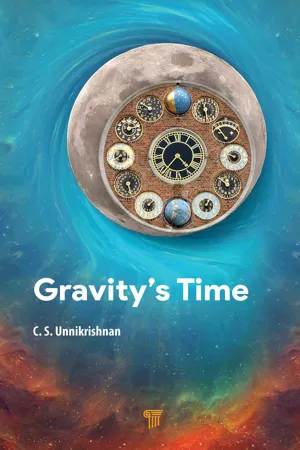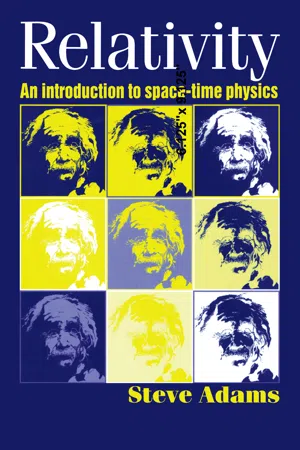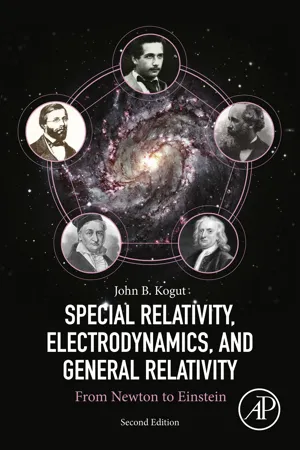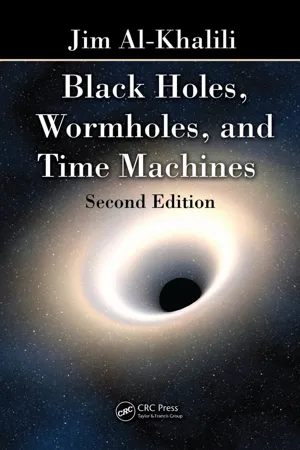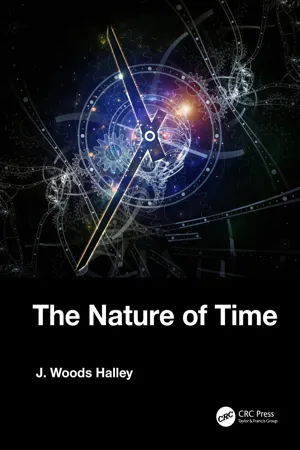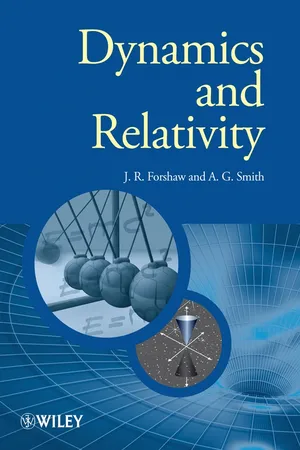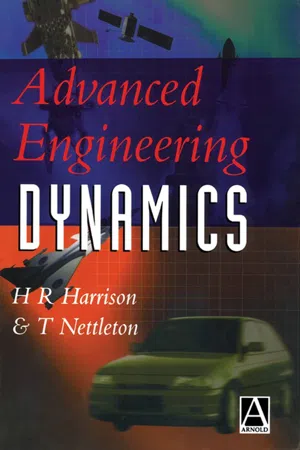Physics
Time Dilation
Time dilation is a phenomenon predicted by Einstein's theory of relativity, where time passes at different rates for observers in different gravitational fields or relative velocities. This means that time can appear to move slower for an observer in a strong gravitational field or moving at high speeds compared to an observer in a weaker gravitational field or at rest.
Written by Perlego with AI-assistance
Related key terms
Related key terms
1 of 4
Related key terms
1 of 3
10 Key excerpts on "Time Dilation"
- eBook - ePub
- A Norton(Author)
- 2019(Publication Date)
- CRC Press(Publisher)
The central conclusion should be that time has lost its absolute nature (as understood in Newtonian mechanics). Clocks do not tick in some relentless sense, measuring some absolute quantity called time. Thus, Time Dilation is a property of time itself; time has become a relative quantity. It is a quantity that is personal to the particular observer who is measuring it. It must be concluded that both the clocks and all life processes of the observer in frame of reference B would slow down relative to the clocks of the observer in frame of reference A. Question 4.7 The distance to the triple star system Alpha Centauri is such that it takes light 4.2 years to travel from that system to the Earth. If an astronaut left the Earth and travelled at a constant speed of 0.9c relative to the Earth towards Alpha Centauri, how long would it take, according to an observer on Earth and according to the astronaut, for him to reach there? ■ 5.3 Lorentz contraction You’ve just seen that, according to special relativity, time is a relative quantity, and its measurement is personal to the particular observer who is measuring it. Now, since time has lost its absolute character, what about length measurements? In fact, was the derivation of the Time Dilation formula careful enough with regard to measuring lengths? After all, in the derivation, it was assumed that the length between the mirrors in the light clock, which was perpendicular to the motion, was unaffected by the relative motion between the observers. To check if this was indeed a safe assumption, look at the new thought experiment in Figure 4.28. Figure 4.28 A thought experim ent on length contraction. The figure shows two spaceships A and B travelling past each other at high speed. Each is equipped with a vertical rod 10 m long, fitted with a marker at its top end; the marker can just scratch a mark on the end of the other rod as they almost touch each other in passing - eBook - ePub
- Raymond Tallis(Author)
- 2017(Publication Date)
- Agenda Publishing(Publisher)
2 , “Time Dilation” hardly seems an eccentric or even bold notion.There are many situations in which physicists see time as dilated. I want to focus on one of the most well-known examples. “Time Dilation” may be observed when a clock A enters a more intense gravitational field compared with clock B. Under such circumstances, “the flow of time” is seen to be more sluggish, as if gravity introduced a kind of viscosity into time. This dilatation of time, due to the increased curvature of the path of light signals is not merely an impression that can be corrected by a measurement from some universal clock, independent of any frame of reference, of what is “really going on”. Access to the nearest we get to “what is really going on” has to be mediated through signals that travel at the maximum possible speed – that of light. And (in accordance with Mach’s verificationist principle of the unreality of unobservables) there could not be anything corresponding to what is “really going on” that is in principle unobservable.But the notion of time itself slowing or speeding up is mired in the idea, that we discussed in §2.2.3 , of time passing at a certain rate – or different rates in different circumstances – and this would require us to refer to a hypertime against which its speed could be measured. What is affected by relative movement (or a gravitational field) is not time itself but precisely what is described: measurement on a clock and noted by an observer of the clock. Time dilatation is a quarrel between clocks, not a local ballooning of time itself. To translate this into literal dilatation – in which (say) seconds become more capacious, able to accommodate more events, as if the latter had a fixed (absolute) duration – is to confuse measurements of time with time itself. As Plotinus said, “to measure something is not to grasp that something”.83 - eBook - ePub
- C. S. Unnikrishnan(Author)
- 2022(Publication Date)
- Jenny Stanford Publishing(Publisher)
Chapter 3 Time and MotionThe most well-known modification of physical time is the Time Dilation of moving clocks in relativity. This is familiar to everyone, being a topic of discussion even in popular literature and films. Slowing down the passage of time significantly is the only hope for even cosmic explorers in fiction to reach the distant worlds in our Universe, within a lifetime.The topic of Time Dilation became an intense topic of discussion and debate within a few years of the publication of the Special Theory of Relativity (STR) by Einstein in 1905 (Einstein, 1905 ), in which he wrote,If one of two synchronous clocks at A is moved in a closed curve with constant velocity until it returns to A, the journey lasting t seconds, then by the clock which has remained at rest the travelled clock on its arrival at A will be tv2 /2c2 second slow.The phenomenon was mentioned by J. Larmor earlier in the context of the periodic motion of electrons. However, Einstein’s explicit and clear prediction of Time Dilation of transported clocks was the first general statement on the motional modification of time as a physical phenomenon observable in any type of clock. It became a topic of debate not because the phenomenon was radically strange, but because of the structure of the STR, in which motion was defined only in terms of relative movement; even the kinematical impression of motion was treated as physical motion in the STR.The study of relativity is the study of physical effects during relative motion. Before Einstein, there were two important insights gained by physicists on relativity. One was Galileo’s realization that the state of uniform motion in a straight line could not be distinguished from the state of rest, by any physical means or experiments. This is distilled from our everyday experience; we often face the situation of the apparition that we are moving, while in fact only an external reference background is moving, as with the slowly moving trains in a station. On the other hand, it is a common and familiar situation that we cannot sense our smooth motion, even when it is at a tremendous speed. We do not feel, and cannot prove, the fast motion of the Earth around the Sun, to the extent of not even believing it for centuries. Therefore, it is reasonable to state that only relative motion makes physical sense. Anybody in uniform motion can claim a state of rest, ascribing the whole motion to the rest of the world. All laws of physics should conform to this ‘Principle of Relativity′ (PoR). In other words, the laws of physics are the same in every frame that is in uniform motion. Uniform rectilinear motion is commonly called inertial motion. There is no acceleration in ideal inertial motion,a →= dv →/ d t = 0. - eBook - ePub
Relativity
An Introduction to Spacetime Physics
- Steve Adams(Author)
- 2017(Publication Date)
- CRC Press(Publisher)
c) and so take longer to complete a cycle. Time Dilation is a reciprocal effect: A sees time slow down in B's frame and B sees time slow down in A's frame. Whichever way we look at it, the ‘moving’ clock always runs slow.Surely there is a paradox here? How is it possible for A's clock to be slower than B's and yet for B's to be slower than A's? We shall face squarely up to problems of this sort later when we consider the twin paradox, but for now an analogy with visual perception might be helpful to bear in mind. Imagine standing some distance away from a friend and then raising your hand at arm's length in front of your face. It is easy to block out their entire image so that they appear smaller than your hand. By the same token they are able to block you out with their hand. Assuming your hands are roughly the same size this could lead to the conclusion that you are smaller than your friend and your friend is smaller than you. There is obviously no great mystery or even a hint of a paradox here, we are very familiar with the effects of perspective.2.6 THE Time Dilation FORMULA.
2.6.1 Comparing Light Clocks.
A simple geometric comparison between light clocks in uniform relative motion leads to a formula that will allow us to calculate the rate at which a ‘moving’ clock ticks. To do this we must compare the time for light to complete one round trip in the ‘moving’ clock with the time for light to complete a similar journey in the ‘stationary’ clock. Before we start we must bear two things in mind. Firstly that ‘stationary’ merely identifies a reference frame from which we intend to make our measurements, that is stationary with respect to us as the observers. The moving frame is moving with respect to us and our measuring apparatus. Secondly, having identified a reference frame from which to make our observations we must remember that all our measured values are on measuring devices fixed in this frame. When we conclude that a moving clock is running slow what we really mean is that if a time t passes between ticks of our own clock then our clock measures a time t’ that is greater than t between ticks on the moving clock. An observer moving with that clock would certainly not think that his or her clock was running slow (in fact, as we have already seen, their conclusion would be that it was our - eBook - ePub
- A.P. French(Author)
- 2017(Publication Date)
- CRC Press(Publisher)
0.7 divided by 6.3 equals 1 9. These mesons moving by us at 0.99 the speed of light keep time at 1 9 the rate they do when they’re at rest with respect to us. The essence of the phenomenon is that a lapse of time as recorded on a single clock is compared to the results of measurements in a reference frame relative to which this clock is moving. In any such comparison, it emerges that the elapsed time as measured on the single clock is less than the difference between the two clock readings that describe the beginning and end of this interval in the other frame. The scale of time as measured by the single clock is apparently stretched out; hence the phrase Time Dilation as a description of it. To see how this remarkable feature is inherent in special relativity, imagine that a single clock is at rest at the point x = x 0 in frame S. Consider two events corresponding to two different readings of the clock: Event 1 : (x 0, t 1) Event 2 : (x 0, t 2) Let us now calculate the time coordinates of these events as measured in the frame S ′ that has a velocity v with respect to S. Using the Lorentz transformations we have t ′ 1 = γ (t 1 − υ x 0 / c 2) t ′ 2 = γ (t 2 − υ x 0 / c 2) Therefore t ′ 2 − t ′ 1 = γ (t 2 − t 1) If the difference t 2 − t 1 is written τ 0 and t ′ 2 − t ′ 1 is written τ, then we. have τ = γ τ 0 = τ 0 (1 − υ 2 / c 2) 1 / 2 (4-5) Compare Eq. (4-5) with (4-4). We see that the measured length of a body is greater in its rest frame than in any other frame, whereas the time difference between the events represented by two readings of a given clock is less in the rest frame of the clock than in any other frame. The time-dilation phenomenon loses most of its mystery once we recognize that it is basically the consequence of comparing successive readings on a given clock with readings on two different clocks. Thus the result expressed by Eq - eBook - ePub
Special Relativity, Electrodynamics, and General Relativity
From Newton to Einstein
- John B. Kogut(Author)
- 2018(Publication Date)
- Academic Press(Publisher)
So, an observer in frame S states that there was a time difference of Δ t ′ = ℓ o v / c 2 in frame S ′ between the time clock 2 received the light ray and the time clock 1 received its ray. But all observers in all frames have noted that clocks 1 and 2 have identical readings when the light rays reach them. Therefore, an observer in frame S concludes that clock 1 was set ahead of clock 2 by an amount ℓ o v / c 2. In other words, when an observer at time t in frame S inquires what the time t ′ is in frame S ′, the observer finds that t ′ depends on x ′: t ′ varies as x ′ v / c 2. The lesson we learn here—that clocks that are synchronized in one frame are not synchronized when measured in a frame at relative motion along the line between the clocks—is crucial to understanding Time Dilation and Lorentz contraction. It is called the “relativity of simultaneity.” These three effects must be taken all together (more on this later). 2.5. Time Dilation Revisited The purpose of this discussion is to understand how Time Dilation, the relativity of simultaneity, and Lorentz contraction conspire together to produce a consistent picture of time measurements of moving clocks [1]. We have already seen that, if two frames S and S ′ are in relative motion, an observer in each says that the other's clock runs slowly. This sounds paradoxical. Let us take a closer look from both observers' perspectives and see that each agrees with the observations of the other. Suppose that there are two synchronized clocks at rest in the frame S and separated by a proper distance ℓ o in the x direction. As usual, let frame S ′ be moving to the right at velocity v, as shown in Fig. 2.7. Let the clock in frame S ′ be synchronized with clock 1, which is at rest in frame S. They pass each other at x = x ′ = 0, t = t ′ = 0, as shown in Fig. 2.7A. We wish to know what Sʹ's clock will read when it passes S's clock 2, as shown in Fig. 2.7B - eBook - ePub
- Jim Al-Khalili(Author)
- 2016(Publication Date)
- CRC Press(Publisher)
If he could see a stopwatch you are holding he would see it counting by the seconds more slowly than his. If he could somehow remotely measure your heartbeat he would find it slower. Everything about you is, according to him, running slower. That’s not all; if you forget about the light beam for a moment, the first principle of relativity implies that you could equally well consider your friend who is standing on the ground to be the one who is moving at three quarters the speed of light, in the opposite direction. You would see his time running slower than yours! This is not some crackpot theory devised to make sense of the ridiculous notion that light would travel at the same speed for everyone. The notion about the speed of light is far from ridiculous and is confirmed all the time these days in experiments in particle accelerators. These are huge laboratories with circular underground tunnels several miles long that send subatomic particles around at close the speed of light, such as the famous CERN facility in Switzerland. The slowing down (called dilation) of time is an unavoidable consequence of this behaviour of high-speed particles. Let me first quickly mention these particle experiments. It is known that certain type of subatomic particles, called pions (pronounced ‘pie-on’), emit photons of light. When a pion is stationary, the photon will, of course, emerge at the speed of light (it is a particle of light after all). But at CERN, pions can be made to move around in a large circular underground tunnel at very close to the speed of light. They still emit their photons however, and those photons emerging in the direction that the pions are moving can be detected and their speed measured - eBook - ePub
- J. Woods Halley(Author)
- 2022(Publication Date)
- CRC Press(Publisher)
CHAPTER 5 Relativity and TimeDOI: 10.1201/9781003037125-5“Time,” he said, “is what keeps everything from happening at once.” Ray Cummings, “The Girl in the Golden Atom”, All-Story Weekly (1919) sometimes attributed to Albert Einstein“‥the supreme goal of all theory is to make the irreducible basic elements as simple and as few as possible without having to surrender the adequate representation of a single datum of experience.” Albert Einstein, “On the Method of Theoretical Physics,” the Herbert Spencer Lecture, Oxford, June 10, 1933, often paraphrased as “Things should be as simple as possible, but not simpler”5.1 INTRODUCTION
A few decades before quantum mechanics was found as a way to describe non-Newtonian behavior of particles on very small scales, physicists found another problem with the Newtonian description of particles moving at very high velocities. The solution to the problem was the special theory of relativity, which describes how the space and time separations of events differ when recorded in frames of reference moving at rapid velocities with respect to one another. There is a second aspect to relativity, called general, as opposed to special, relativity, which is basically a theory of gravity, also differing from Newton's description but reducing to it in low gravitational fields and velocities. In this chapter I will be mainly concerned with the special theory.5.2 WARPING NEWTONIAN TIME
To try to make these matters as clear as possible, I begin with the description of a wave moving on water, say on a lake, with some velocity, which I will callc, in a straight line (no curves). Now we imagine that the wave is passing by a dock and that a person has set up a measurement scheme to measure the velocity of waves moving past the dock. (See Figure 5.1 .) The person has made two marks on the dock, a distance, call itw a t e rΔ x, apart. She also has some kind of stopwatch in order to measure the time, call itΔ t, between the moment when a wave passes the first mark and the time when it passes the second mark a distanceΔ xaway from the first mark along the dock. She simply starts the stopwatch when the wave passes the first mark and stops it when the wave passes the second mark. The person on the dock then has enough information to calculate the speed of the wave (c= Δ x / Δ tw a t e r - eBook - ePub
- Jeffrey Forshaw, Gavin Smith(Authors)
- 2014(Publication Date)
- Wiley(Publisher)
t . Therefore the perceived time interval between the start and the end of the tick is(6.8 )It is very important to be clear that this extra slowing down of the clock is an ‘optical illusion’, in contrast to the Time Dilation effect which is a real slowing down of time. To emphasise this point, if light travels at a finite speed then moving clocks will appear to run slow even in classical theory such that Δt see = Δt ′(1 + v/c ).Eq. (6.8) leads us on nicely to the Doppler effect for light. Let us consider the situation illustrated in Figure 6.4 . A light source is at rest in S ′ and is being watched by someone at rest in S . The time interval Δt ′ could just as well be the time between the emission of successive peaks in a light wave, i.e. the frequency of the wave is f ′ = 1/Δt ′. The person watching the light source will instead see a frequency f = 1/Δt . The two frequencies are related using Eq. (6.8) :Figure 6.4 A light source of frequency f ′ at rest in S ′(6.9 )This is the result in the case that the light source is moving away from the observer, in which case Eq. (6.9) tells us that f < f ′ and so the light appears shifted to shorter frequencies, i.e. it is ‘red-shifted’. If the source is moving towards the observer we should reverse the sign of v in Eq. (6.9) and therefore conclude at f > f ′, i.e. the light is now ‘blue-shifted’.Example 6.1.2 How fast must the driver of a car be travelling towards a red traffic light (λ = 675 nm ) in order for the light to appear amber (λ = 575 nm )?Solution 6.1.2 In the rest frame of the car, the traffic light is moving towards them at a speed u. Our task is to determine u given the change in wavelength. We can convert wavelengths to frequencies using c - eBook - ePub
- H. Harrison, T. Nettleton(Authors)
- 1997(Publication Date)
- Butterworth-Heinemann(Publisher)
equation (9.37) , and similarly the second term on the left is equal to the second term on the right. Because [η] is symmetrical the fourth terms are the transposes of the respective third terms and since these are scalars they must be equal. From this argument we have that(9.37a)and is another invariant.9.3 Time Dilation and proper time
It follows from equations (9.37) and (9.37a) that if (ΔE ) = (E 2 − E 1 ) then the productis an invariant. In full(9.39)Because the relative motion is wholly in the x directionso equation (9.39) can be written as(9.40)which is invariant.If Δct′ is the difference in time between two events which occur at the same location in the moving frame, that is Δx′ = 0, equation (9.40) tells us thatBut x = vt = βct and thereforeand by the definition of γ, equation (9.29) , we have that(9.41)The two events could well be the ticks of a standard clock which is at rest relative to the moving frame.Because γ > I, (Δct ) > (Δct′ ); that is, the time between the ticks of the moving clock as seen from the fixed frame is greater than reported by the moving observer. This Time Dilation is independent of the direction of motion so it is seen that an identical result is obtained if a stationary clock is viewed from the moving frame. It is paramount to realize that the dilation is only apparent; there is no reason why a clock should run slow just because it is being observed.For example, if the speed of the moving frame is 86.5% of the speed of light (i.e. β = 0.865) then γ = 2. If the standard clock attached to the moving frame ticks once every second (i.e. Δct′ = 1) then the time interval as seen from the fixed frame will be Δct = γ(Δct′
Index pages curate the most relevant extracts from our library of academic textbooks. They’ve been created using an in-house natural language model (NLM), each adding context and meaning to key research topics.
Explore more topic indexes
Explore more topic indexes
1 of 6
Explore more topic indexes
1 of 4
